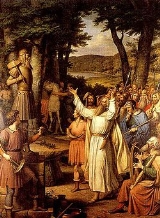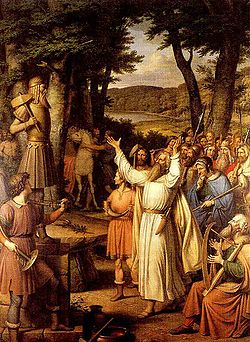
Gothi
Encyclopedia

Priest
A priest is a person authorized to perform the sacred rites of a religion, especially as a mediatory agent between humans and deities. They also have the authority or power to administer religious rites; in particular, rites of sacrifice to, and propitiation of, a deity or deities...
and chieftain
Tribal chief
A tribal chief is the leader of a tribal society or chiefdom. Tribal societies with social stratification under a single leader emerged in the Neolithic period out of earlier tribal structures with little stratification, and they remained prevalent throughout the Iron Age.In the case of ...
. Gyðja signifies a priestess.
The name appears in Wulfila's Gothic language
Gothic language
Gothic is an extinct Germanic language that was spoken by the Goths. It is known primarily from the Codex Argenteus, a 6th-century copy of a 4th-century Bible translation, and is the only East Germanic language with a sizable Text corpus...
translation of the bible
Codex Argenteus
The Codex Argenteus, "Silver Book", is a 6th century manuscript, originally containing bishop Ulfilas's 4th century translation of the Bible into the Gothic language. Of the original 336 folios, 188—including the Speyer fragment discovered in 1970—have been preserved, containing the...
as gudja for "priest", but in Old Norse it is only the feminine form gyðja that perfectly corresponds to the Gothic form. The corresponding masculine Old Norse form would have been an unattested *gyði.
In Scandinavia there are surviving early attestations in the Proto-Norse form gudija from the Norwegian Nordhuglo runestone (Rundata
Rundata
The Scandinavian Runic-text Data Base is a project involving the creation and maintenance of a database of runic inscriptions. The project's goal is to comprehensively catalog runestones in a machine-readable way for future research...
N KJ65 U), and in the later Old Norse form goði from two Danish runestones, the Glavendrup stone
Glavendrup stone
The Glavendrup stone, designated as DR 209 by Rundata, is a runestone on the island of Funen in Denmark and dates from the early 10th century. It contains Denmark's longest runic inscription and ends in a curse.-Description:...
(DR 209) and the Helnæs Runestone (DR 190). There are also a few placenames, such as Gudby in Södermanland
Södermanland
', sometimes referred to under its Latin form Sudermannia or Sudermania, is a historical province or landskap on the south eastern coast of Sweden. It borders Östergötland, Närke, Västmanland and Uppland. It is also bounded by lake Mälaren and the Baltic sea.In Swedish, the province name is...
, Sweden
Sweden
Sweden , officially the Kingdom of Sweden , is a Nordic country on the Scandinavian Peninsula in Northern Europe. Sweden borders with Norway and Finland and is connected to Denmark by a bridge-tunnel across the Öresund....
, that probably retain the name.
Otherwise, there are no further surviving attestations except from Iceland where the goðar would be of historical significance. The goðar are depicted in the Sagas
Norse saga
The sagas are stories about ancient Scandinavian and Germanic history, about early Viking voyages, the battles that took place during the voyages, about migration to Iceland and of feuds between Icelandic families...
as the religious and political leaders of their district or goðorð. In Iceland
Iceland
Iceland , described as the Republic of Iceland, is a Nordic and European island country in the North Atlantic Ocean, on the Mid-Atlantic Ridge. Iceland also refers to the main island of the country, which contains almost all the population and almost all the land area. The country has a population...
, prior to Christianization
Christianization
The historical phenomenon of Christianization is the conversion of individuals to Christianity or the conversion of entire peoples at once...
, religious temples or hofs
Heathen hofs
Heathen hofs or Germanic pagan temples were the temple buildings of Germanic paganism; there are also a few built for use in modern Germanic neopaganism...
were privately owned and maintained by a hofgoði or temple priest. They were also an important part of the Icelandic political system for a long time after the arrival of Christianity.
The term goði is often used as a priestly title by modern adherents of various denominations of Germanic Neopaganism
Germanic Neopaganism
Germanic neopaganism is the contemporary revival of historical Germanic paganism. Precursor movements appeared in the early 20th century in Germany and Austria. A second wave of revival began in the early 1970s...
, especially in Ásatrú
Ásatrú
is a form of Germanic neopaganism which developed in the United States from the 1970s....
.
A goðorð or godord refers to a domain or an area of influence controlled by an Iceland
Iceland
Iceland , described as the Republic of Iceland, is a Nordic and European island country in the North Atlantic Ocean, on the Mid-Atlantic Ridge. Iceland also refers to the main island of the country, which contains almost all the population and almost all the land area. The country has a population...
ic medieval chieftain, or goði.

